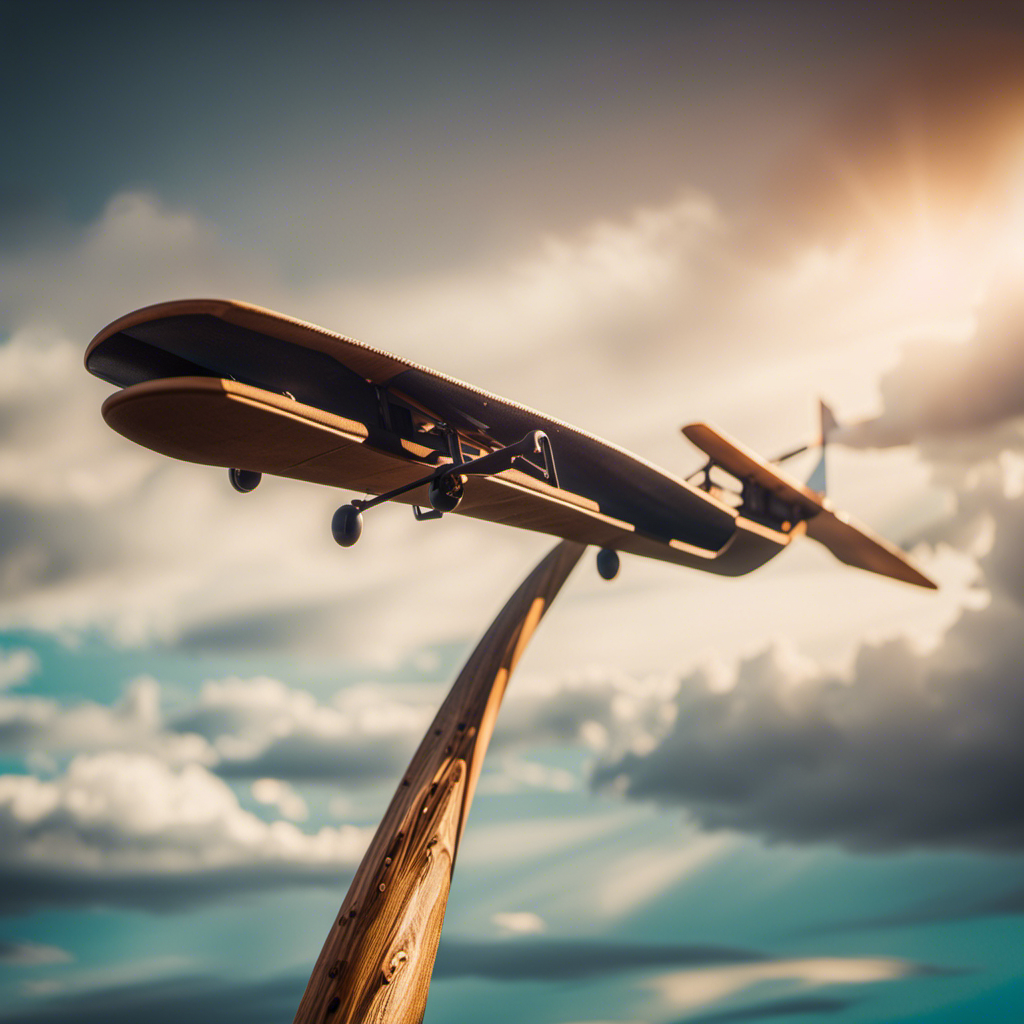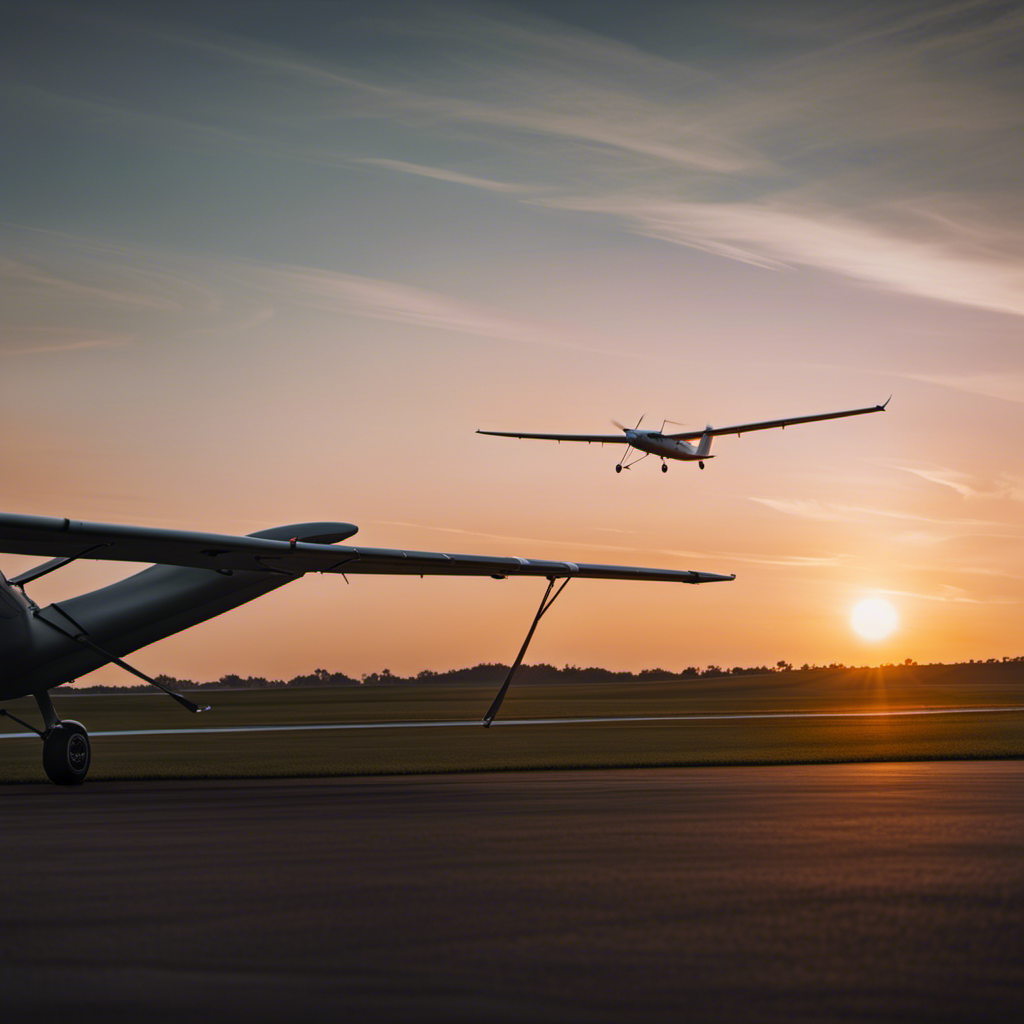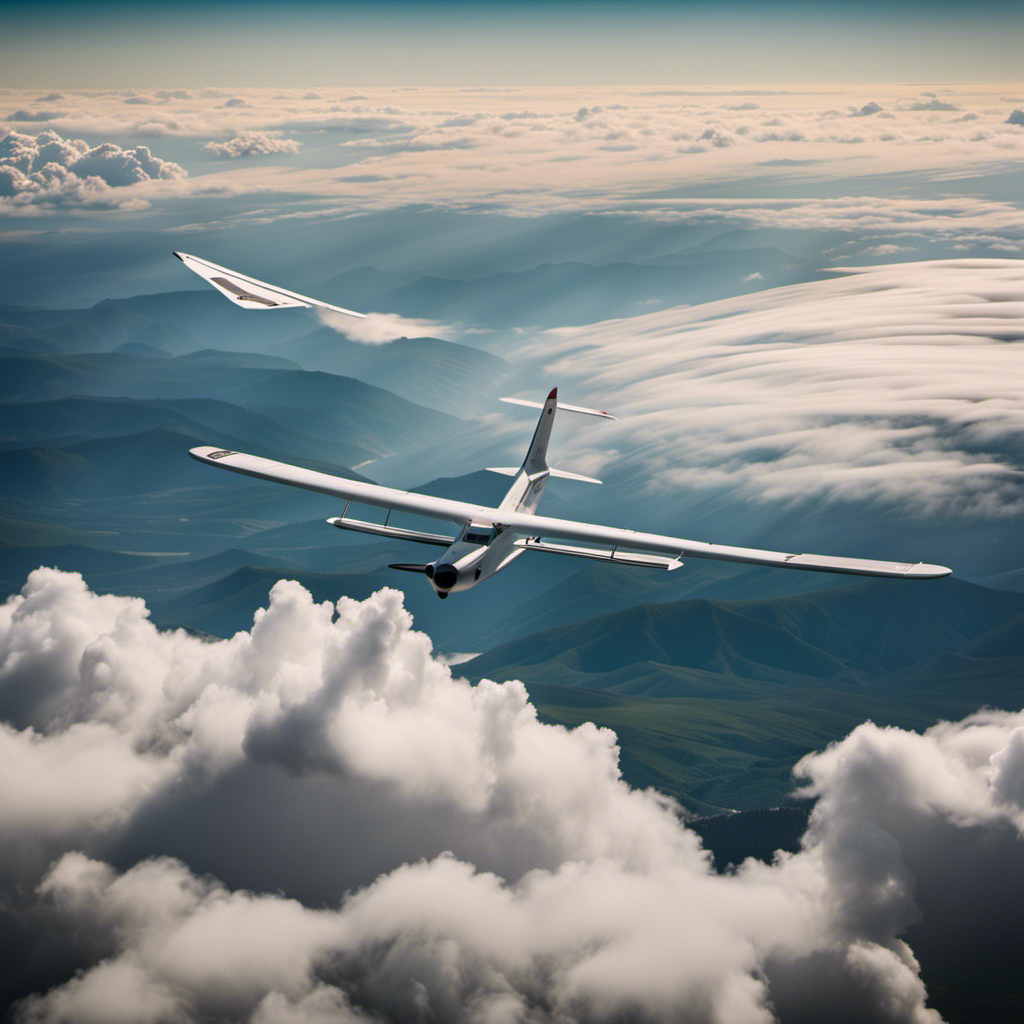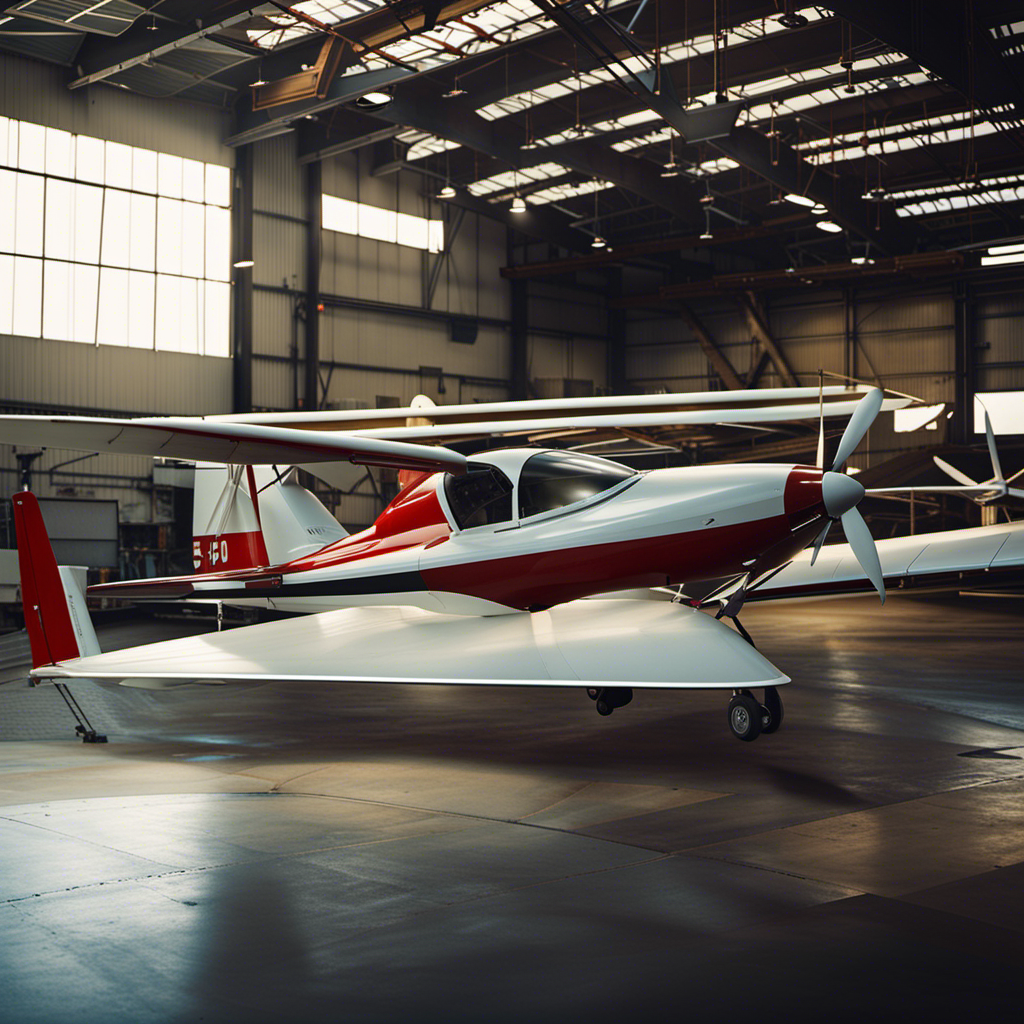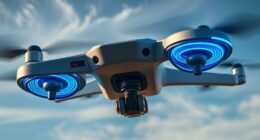I have always been fascinated by the wonders of aviation, and launching a foam glider into the sky provides a thrilling opportunity to interact with these marvels firsthand.
Did you know that a well-executed launch can send a foam glider soaring through the air for distances of up to 100 feet?
In this article, I will guide you step by step through the process of assembling and using a catapult to launch your foam glider.
Get ready to feel the rush of the wind beneath your wings as you master this exhilarating technique.
Key Takeaways
- Gradual ascent for altitude and stability
- Medium angle for balance between altitude and distance
- High angle for maximum altitude but sacrificing forward distance
- Experiment to find optimal trajectory
Gather Your Materials
Before you can launch your foam glider, you’ll need to gather all of your materials.
First, find a large, open space with minimal wind to maximize your glider’s flight.
Next, gather your foam glider assembly kit, which typically includes the foam glider body, wings, tail, and any necessary adhesive or connectors. Ensure that all the pieces are in good condition and free from any defects.
Additionally, you’ll need a catapult to launch your glider. This can be either a pre-made catapult or one that you assemble yourself using materials like wood or PVC pipes.
Once you have all your materials gathered, you can move on to the next step of assembling the catapult.
Assemble the Catapult
Once you’ve gathered all the necessary materials, it’s time to start putting the catapult together.
The first step in catapult construction is to assemble the frame. Begin by connecting the two base pieces with the vertical support using screws or nails. Make sure they are securely fastened to ensure stability.
Next, attach the launching arm to the vertical support using a pivot point, such as a bolt or a metal rod. This will allow the arm to move smoothly.
To ensure proper tension, attach rubber bands or springs between the base and the arm.
Lastly, test the catapult by pulling the arm back and releasing it to see if it launches smoothly.
With the catapult construction complete, it’s time to position the foam glider for launch.
Position the Foam Glider
To properly position it, you’ll want to carefully place the foam glider on the launching arm of the assembled catapult. Ensuring the glider is positioned correctly is crucial for a successful launch. Here are some positioning techniques and launching strategies to keep in mind:
| Positioning Techniques | Launching Strategies |
|---|---|
| Align the glider with the straight edge of the launching arm. | Make sure the glider is securely fastened to the arm using rubber bands or tape. |
| Place the glider towards the front of the arm for a higher launch angle. | Adjust the position of the glider to achieve the desired flight trajectory. |
| Ensure the glider is centered on the arm for balanced flight. | Apply a smooth and controlled force when releasing the catapult. |
Adjust the Catapult Tension
Adjusting the tension on the catapult will determine the performance and distance of the launch. To achieve the best results, it is crucial to find the optimal launch angle.
Start by assessing the current tension on the catapult. You can adjust the tension by either tightening or loosening the catapult’s elastic bands. A higher tension will result in a more powerful launch, while a lower tension will provide a gentler launch. Experiment with different tension levels to find the perfect balance for your foam glider.
Once you have adjusted the tension, it’s time to focus on holding the catapult properly. By holding it firmly and ensuring a stable grip, you can maximize the force and accuracy of your launch.
Hold the Catapult Properly
Ensure you have a secure grip on the catapult to maximize its force and accuracy. Holding the catapult properly is crucial for a successful launch of the foam glider. Here are four key aspects to consider when gripping the catapult:
-
Hand placement: Position your dominant hand towards the base of the catapult, ensuring a firm grip on the handle. Your fingers should wrap around the handle, providing stability and control.
-
Thumb position: Place your thumb along the side of the catapult, opposite your fingers. This allows for additional support and stability during the launch.
-
Wrist alignment: Keep your wrist straight and aligned with your forearm. This ensures proper transfer of force from your arm to the catapult, maximizing the power of the launch.
-
Grip strength: Maintain a strong grip on the handle, but avoid excessive tension. Too much force can hinder your launching technique and affect the glider’s trajectory.
With a secure grip, you’re ready to release the glider, propelling it into the air with precision and accuracy.
Release the Glider
When releasing the glider, be sure to maintain a steady grip on the catapult handle. This is crucial for a successful launch and for maximizing the distance your foam glider can travel. Proper technique and timing are key when it comes to releasing the glider. As you pull back the catapult handle, you need to smoothly and steadily release it at the right moment to achieve the desired launch trajectory. Here is a table outlining some launching techniques that can help you maximize the distance of your glider:
| Technique | Description |
|---|---|
| Angle | Adjust the angle of the catapult for different distances. A higher angle will result in a steeper ascent and longer flight. |
| Force | Vary the force applied to the catapult to control the speed of the launch. Stronger force can lead to greater distance. |
| Release Timing | Experiment with the timing of the release to find the sweet spot where the glider gains the most height and distance. |
Practice and Perfect Your Technique
To improve your technique, you can practice different launching methods and fine-tune your skills. This will not only help improve accuracy but also increase the distance your foam glider can fly.
One method you can try is the two-handed launch. Hold the glider with one hand gripping the tail and the other hand holding the catapult. Pull the catapult back with a smooth and steady motion, aiming the glider in the desired direction. Release the glider at the right moment, making sure to let go of the tail first.
Another technique to experiment with is the one-handed launch. Hold the glider by the tail with one hand and pull the catapult back with the other hand. This method allows for more control and precision.
By practicing these different launching methods, you can improve your accuracy and increase the distance your foam glider can fly.
Now let’s move on to the next section and explore how to experiment with different launch angles.
Experiment with Different Launch Angles
Experimenting with different launch angles can greatly impact the trajectory and distance that your foam glider will travel. By adjusting the angle at which you launch the glider, you can optimize its flight path and maximize its distance.
Here are three key angles to experiment with:
-
Launch at a low angle (around 10 degrees): This will result in a smooth and gradual ascent, allowing the glider to gain altitude slowly while maintaining stability.
-
Launch at a medium angle (around 30 degrees): This angle provides a good balance between altitude and distance. The glider will climb more steeply but will also maintain a decent forward momentum.
-
Launch at a high angle (around 45 degrees): This angle will result in a steep ascent, allowing the glider to gain maximum altitude. However, it may sacrifice some forward distance.
By experimenting with these different launch angles, you can find the optimal trajectory for your foam glider.
Transitioning into the subsequent section, let’s now troubleshoot common launching issues without writing ‘step’.
Troubleshoot Common Launching Issues
If your foam glider is not achieving the desired distance or altitude, there might be some common launching issues that need troubleshooting. To improve launch distance, make sure you are launching the glider at the right angle and with enough force.
First, check if the glider is balanced properly. Adjust the position of the wings and tail to ensure stability during flight.
Next, ensure that you are launching the glider with enough force. Pull the catapult back as far as possible and release it smoothly and evenly.
If the glider is not reaching the desired height, try adjusting the launch angle. Experiment with different launch angles to find the optimal one for your glider.
Enjoy the Thrill of Flying Your Foam Glider
Experience the exhilaration of flying your foam glider and embrace the thrill of soaring through the air. The feeling of the wind rushing past as you launch your glider is unmatched.
As you explore different foam glider designs, you’ll discover the joy of experimenting with various shapes and sizes. Whether it’s a sleek, streamlined glider or a more unconventional design, each flight brings its own unique experience.
The wind resistance encountered during flight adds an extra element of excitement, as you skillfully navigate through the air currents. With every launch, you’ll gain a deeper understanding of aerodynamics and how it affects the performance of your glider.
So strap in, release the catapult, and let your foam glider take flight, as you embark on an adventure like no other.
Frequently Asked Questions
How do I choose the right foam glider for catapult launching?
To choose the right foam glider for catapult launching, consider factors like weight, wing shape, and durability. Look for gliders specifically designed for high launch speeds and stability. Test different models to find the one that performs best with your launching techniques.
What is the optimal tension for the catapult when launching a foam glider?
The optimal tension for launching a foam glider with a catapult depends on the desired launch distance. Achieving the correct tension is crucial for maximizing the glider’s flight path and ensuring a successful launch.
Are there any safety precautions I should take when launching a foam glider with a catapult?
When launching a foam glider with a catapult, it is crucial to follow safety measures and proper launching techniques. This includes wearing protective eyewear, ensuring a clear launch area, and using a secure and stable catapult mechanism.
Can I launch a foam glider with a catapult indoors?
To launch a foam glider indoors, alternative methods are needed. One option is using a hand launch technique, where you hold the glider by the fuselage and throw it with enough force to achieve flight.
How far can a foam glider typically be launched with a catapult?
Typically, a foam glider can be launched with a catapult to a maximum distance by modifying it for improved aerodynamics and calculating the launch angle using precise mathematical formulas.
Conclusion
After following the steps outlined in this guide, I was able to successfully launch a foam glider using a catapult.
By gathering the necessary materials, assembling the catapult, and adjusting the tension, I was able to position the foam glider properly and hold the catapult in the correct manner.
With practice, I was able to perfect my technique and experiment with different launch angles.
Troubleshooting common launching issues allowed me to enjoy the thrill of flying my foam glider.
Overall, this method proved to be effective and provided a visual representation of the ideas discussed.
